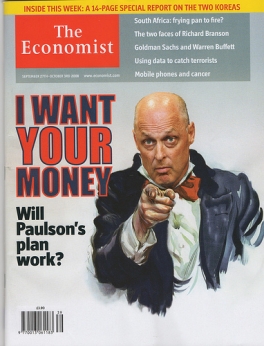Too Much Regulation Or Not Enough?

SYDNEY: 19 July 2013 - The Economist’s Bellwether Series in Sydney brought together a stellar line-up of economists, central bankers, journalists, politicians and academics. The running thread throughout the daylong conference was the age old discussion about how far regulation should go.
Has the regulatory response to the Global Economic Crisis achieved a proportionate balance, is excessive regulation producing the unintended consequences of stilting innovation or has regulation some way to go before it creates an environment which ensures that the sins of the past will never be repeated?
Charles Goddard, Editorial Director, Asia-Pacific of The Economist Intelligence Unit, noted that Asia was “not well served by the global architecture” and asked if there was a move towards greater regulatory consistency in the region. Regulatory reform is not as urgent in Asia. Instead, it is West meets East as America and Europe look to the post 1990s Asian response to financial crisis. The Basel II and Basil III process were regarded by Asian entities as secondary to existing directives as many of the guidelines, particularly in terms of capital requirements, had already been achieved or near completion.
Although the Asian financial sector is less developed than other regions, this proved advantageous and insulated Asia from the excesses of the GFC. The catastrophe that engulfed the sophisticated derivative industry was largely a Western rather than Eastern problem. Harmonisation of regulation and the creation of a level playing field for foreign banks were priorities for Anton Gunawan, Chief Economist of the Bank Danamon of Indonesia.
Art Certosimo, Chief Executive Officer of BNY Mellon, believed that the Asian central bankers were engaging in the “spirit” of change. He cautiously noted however that the unintended consequence of the “pace of change… is potentially dangerous.”
The US zeal for regulation is of concern from an Asian perspective insofar as the additional reporting requirements under Dodd Frank has translated into a loss of counter-parties for those Asian financial entities reluctant to engage in American imposed regulatory obligations. The long-term effect of fewer counter-parties is less liquidity in the markets.
Discussion also centred on the definition of banking. John Denton, Partner and Chief Executive Officer of Corrs Chambers Westgarth, proposed that the purpose of banking was “To take saving and safely transfer them into productive investments for the benefit of the real economy.” The financial sector, he counselled, had moved from being a mere “handmaiden to the centre with an obligation to drive the real economy” with the upshot that reputation was now more important than before. Denton answered his own rhetorical question with an air of despondency. “Is the financial sector living up to that promise? …you would have to say that the answer to that is no.”
The fragmentation of the global regulatory infrastructure is a significant concern as regional focus on implementation differed considerably. The issue of the 1990s is no longer one of market access but market integration. Indeed, members of the audience were apprehensive about the level of knowledge by financial market participants and regulatory players in this dialogue about the shift in economic activity.
Another challenge was at the institutional level. How do you propel reform within the economies themselves? From his experience at APEC, Denton suggested that policy discussions on regulatory restructuring were often limited to Trade Ministers who have no authority at driving domestic economic reform. The debate, he believed, needed to fundamentally shift in the direction of Finance Ministers by introducing a meaningful agenda which marries economic integration and financial services reform to support this.
The collaboration of public and private actors to sustain and implement this program is an essential component of that process. Communiqués from international organisations such as APEC or the G20, are no longer an adequate response. The complexity, nuances and interconnections of the sector can only be understood through innovative partnerships between public and private. More importantly, the successful implementation of consequential and profound change will only come from within rather than that imposed from externalities.
With regard to achieving a balance between regulation, reform and the opening of markets, Gary Pinshaw, partner at McKinsey and Company, stated that the financial services sector needed to move towards more self-regulation, though “that has not always proved to be the best way about it.”
Caution was urged against blindly implementing market regulations designed for developed countries and blanketly imposing them on less developed regions. The disparity between the individual context of countries and uniform one-size-fits-all regulation was ultimately counterproductive.
Nonetheless, crisis is an opportunity or a “circuit breaker” as Paul Kelly, editor-at-large of The Australian, described it. The public policy process is now forced to consider alternative means to address regulatory failure. The top-down, government imposed approach to date had served, in some instances, to create new problems without addressing deep-rooted underlying concerns.


Add new comment